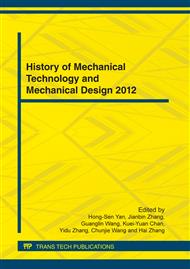p.91
p.95
p.100
p.107
p.111
p.116
p.121
p.125
p.133
Dynamic Analysis and Design of Compliant Mechanisms Using the Finite Element Method
Abstract:
Compliant mechanisms gain at least some of their mobility from the deflection of flexible members rather than from movable joints only. Dynamic effects are very important to improving the design of compliant mechanisms. An investigation on the dynamics and synthesis of the compliant mechanisms is presented. The dynamic model of compliant mechanisms is developed at first. The natural frequency and sensitivity are then studied based on the dynamic model. Finally, optimal design of compliant mechanism is investigated. The experimental study of natural frequency is performed. The comparison between the experiment results and the theoretical results verifies the validity of the experiment system and theoretical model.
Info:
Periodical:
Pages:
111-115
Citation:
Online since:
April 2012
Authors:
Keywords:
Price:
Сopyright:
© 2012 Trans Tech Publications Ltd. All Rights Reserved
Share:
Citation:


